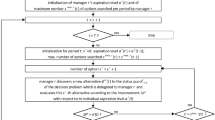Abstract
Koh (Soc Choice Welf 25:207–220, 2005) studied the project evaluation problem when decision-makers in an organization are fallible and showed that in the absence of evaluation costs the optimal organization size and the optimal majority rule are not unique. We show that, in the absence of evaluation costs, the optimal organization size is \(\infty \), which is also conventional because more evaluations can always lead to better judgment. Thus, more evaluations are desirable when there are no additional costs. Koh (Soc Choice Welf 25:207–220, 2005) also claimed that, in the presence of evaluation costs, polyarchy and hierarchy are the only possible optimal structures. We disprove this conclusion using a simple numerical example.
Similar content being viewed by others
References
Benen-Yashar R, Nitzan S (1997) The optimal decision rule for fixed size committees in dichotomous choice situations: the general result. Int Econ Rev 38(1):175–187
Benen-Yashar R, Nitzan S (2001) Investment criteria in single and multi-member economic organizations. Public Choice 109:1–13
Bolton P, Dawatripont M (1994) The firm as a communication network. Q J Econ 109:809–839
Jost PJ, Lammers F (2009) The organization of project evaluation under competition. Rev Manag Sci 3:141–155
Koh W (2005) The optimal design of fallible organizations: invariance of optimal decision threshold and uniqueness of hierachy and polyarchy structures. Soc Choice Welf 25:207–220
Persico N (2004) Committee design with endogenous information. Rev Econ Stud 71:165–191
Sah R, Stiglitz J (1986) The architecture of economic systems: hierarchies and polyarchies. Am Econ Rev 76(4):716–727
Sah R, Stiglitz J (1988) Committees, hierarchies and polyarchies. Econ J 98:451–470
Visser B (2000) Organizational communication structure and performance. J Econ Behav Org 42:231–252
Visser B (2002) A new approach to the complexity of decision problems Erasmus MC: University Medical Center Rotterdam. http://hdl.handle.net/1765/11758. Accessed 1 Oct 2015
Acknowledgements
Funding was provided by Australian Research Council (DP130100766) and Australian Research Council (AU) (DP160104292).
Author information
Authors and Affiliations
Corresponding author
Additional information
The authors thank the referee team for providing critical and constructive comments, leading to this much improved version of this paper.
Appendix
Appendix
1.1 Proof of Lemma 2
Let \(p_Q\) be the probability of an evaluator recommending a project when \(Q=G\) or B. \(p_G= 1-H(\theta |G)\) and \(p_B = 1-H(\theta |B)\). Thus, \(P(\theta , n, k , Q) \equiv P(p, n, k)\). By definition, for any n and k,
and
We therefore have
Because \( - (n+1-k)/k < 0\), this shows \(V(n+1, k + 1) - V(n, k)\) and \([V(n+1, k) - V(n, k)]\) must always have different signs, implying that V(n, k) is between \(V(n+1, k + 1)\) and \(V(n+1, k)\), i.e.,
1.2 Proof of Theorem 1
We will show that no finite number \(n^*\) exists. Suppose there is a finite optimal organization size, \(n^*\), the optimal majority rule \(k^* (\le n^*)\) also finite. From Lemmas 1 and 2, it is easy to see that
This also indicates that \(n^*+1\), and thus, \(n^*+2\), \(n^*+3,\ldots \) are all optimal.
From (15), we have
Similarly if \(n^*+1\) is also optimal, we have
which implies
This contradicts our assumption. Therefore, \(n^* = \infty \) is the only optimal solution for n.
Rights and permissions
About this article
Cite this article
Zhu, M., Liu, C. & Wang, YG. A comment on Koh’s “The optimal design of fallible organizations: invariance of optimal decision threshold and uniqueness of hierarchy and polyarchy structures”. Soc Choice Welf 48, 385–392 (2017). https://doi.org/10.1007/s00355-016-1009-5
Received:
Accepted:
Published:
Issue Date:
DOI: https://doi.org/10.1007/s00355-016-1009-5




